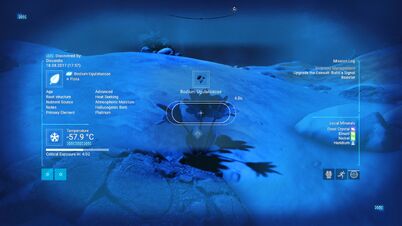| The subject of this article is from the Visions update.
The information from this article is up-to-date as of 13 August, 2019. |
The information from this article is up-to-date as of 13 August, 2019.

Flora is scannable plant life.
Summary
Flora is the procedurally generated, scannable plant life occurring on a planet in No Man's Sky. Grass is generally considered backdrop and not part of the scannable flora. On many toxic and radioactive planets, small mushrooms may take the place of grass and are also unscannable. The type of plant life depends upon what kind of planet the flora is living on.
Most species can be mined using the Multi-tool for Carbon and some species can be picked for special elements. The scanner will indicate which resource you will get. For a list of plants containing special elements see resource,
Flora can be renamed and uploaded for Nanite Clusters. There is no indication how many different flora species are on a planet and scanning them does not count towards completing zoology efforts.
Some flora are hazardous and will hurt the player if they step too close.
Scan Data
The properties of the plant are procedurally generated terms and don't have an effect on the gameplay, aside from Primary Element and Secondary Element. Note that Age, Primary Element, and Secondary Element cannot be viewed in the Discoveries.
- Age: Plant Age
- Root Structure: Plant Roots
- Nutrient Source: Plant Food
- Notes: Plant Notes
- Primary Element
- Secondary Element
The bolded texts above are defined in the game file, the sequence is taken from there as well.
Plant Age
- Ancient
- Old
- Timeless
- Millenia
- Centuries
- Fresh
- Sproutling
- Sapling
- Young
- Decades
- Moderate
- Mature
- Seasoned
- Juvenile
- Fully Grown
- Youthful
- Advanced
- Mature
- Ancient
- Fresh
- Unknown
- Indeterminate
- Regenerating
- Perpetual
- Cyclical
- Mature
- Fully Grown
- Seasoned
- Sproutling
- Sapling
- Young
- Millenia
- Centuries
- Decades
- Several Days
- Still Growing
- Infant
- Immature
- Fully Developed
- Dying
Plant Roots
- Complex
- Fractal
- Widespread
- Stunted
- Swamped
- Desiccated
- Extensive
- Concentrated
- Symbiotic
- Fungal
- Localised
- Bi-directional
- Many-Limbed
- Gravitational
- Unsupported
- Inorganic
- Significant
- Efficient
- Far Reaching
- Capacious
- Limited
- Narrow
- Restricted
- Parasitic
- Invasive
- Extendable
- Voluminous
- Global
- Knotted
- Linear
- Branching
- Substantial
- Conventional
- Circular
- Independent
- Sentient
- Heat Seeking
- Simple
- Regular
- Polygonal
- Not Present
- Hidden
- Balanced
- Omni-Directional
- Irregular
- Transferrable
- Mobile
- Obtuse
- Unfathomable
- Grasping
Plant Food
- Decomposition
- Fungal Harvest
- Air Leaching
- Photosynthesis
- Carnivorous
- Radiotrophic
- Free Radicals
- Autotrophic
- Parasitic Leaching
- Infrared Radiation
- Entrapment
- Conjuration
- Atmospheric Moisture
- Osmosis
- Lost Insects
- Gas Clouds
- Heavy Rain
- Electron Donors
- Photosynthesis
- Photosynthesis
- Photosynthesis
- Photosynthesis
- Atmospheric Moisture
- Fungal Symbiosis
- Membrane Compression
- Nitrogen Fixation
- Carbon Absorption
- Soil Recycling
- Radio Waves
- Meditation
- Atmospheric Moisture
- Carnivorous
- Fungal Reclamation
- Proton Recycling
- Salt Fusion
- Soil Bacteria
- Natural Carbon
- Buried Treasure
- Buried Carbon
- Buried Nitrogen
- Underground Bubbles
- Moonlight
- Sunlight
- Ultraviolet Radiation
- Gamma Rays
- Sublimated Nitrogen
- Rock Enzymes
- Carnivorous Roots
- Fermented Corpses
- Aerobic Digestion
- Anaerobic Digestion
- Theft
- Cosmic Radiation
- Heat Recycling
- Geological Energy
- Thermal Capture
- Liquid Ammonia
- Other Plants
- External Maintenance
- Photosynthesis
Plant Food - Weird
- Gravitational Waves
- Stray Particles
- Time Threads
- Lost Travellers
- [UNKNOWN]
- [NOT DETERMINED]
- Predatory
- Self-Sustaining
- The Unfortunate
- The Lost
- Doomed Wanderers
- Non-existent Insects
- Anomalous Nutrients
- Heavy Metals
- Stardust
- Feeds on Failure
- Dark Matter
- Dark Energy
- Time Bubbles
- Synthesised from Fire
Plant Notes
- Mono-Seasonal
- Sensitive to Light
- Potentially Medicinal
- Hollow
- Insect Habitation
- Toxic Bark
- Bitter Stems
- Unpollinated
- Bioluminescent
- Succulent Tubers
- Waxy Fruit
- Infrequent Flowering
- Edible Seeds
- Inconsistent Blossom
- Inedible Petals
- Pungent
- Nocturnal Pollinators
- Parasite Host
- Omni-Seasonal
- Bi-Seasonal
- Caustic Sap
- Psychotropic Leaves
- Hallucogenic Bark
- Extendible Fronds
- Stinging Hairs
- Annual Spore Clouds
- Sentient Fruit
- Hidden Tentacles
- Itchy Pollen
- Hypnotic Perfume
- Calming Scent
- Pheromone Sacs
- Translucent Nuts
- Crepuscular Fruit
- Self-Healing Bark
- Delicate Stems
- Irresistible Seeds
- Wailing Roots
- Umbral Sprouts
- Movement Prone
- Airborne Seeds
- Multicolour Wood
- Photosensitive Tendrils
- Iridescent Seed Pods
- Retractable Fronds
- Metallic Nodules
- Partially Developed Eyes
- Sneaky
- Whispering Leaves
- Haunted Nests
- Nesting Moths
- Unripe Fruit
- Inner Beauty
- Hibernating
- Biologically Inert
- Self-Pollinating
- Inaudible
- Frost Resistant
- Carbon Dense
- Delicious
- Proto-Skeletal
- Ticklish Stamen
- Four Dimensional
- Ocular Irritant
- Mist-Based Defences
- Cloud Generator
- Pharmacologically Active
- Altitude Tolerant
- Drought Resistant
- Tidal Sap
- Easily Startled
- Meaty Roots
- True Neutral
- All Colours
- Blight Resistant
- Water Laden
- Durable Fruit
- Wind-Blown Seeds
- Mobile
- Genetically Diverse
- Cloned
- Rapidly Mutating
- Faintly Singing
- Pleasing Aroma
- Slowly Rotting
- Extremely Poisonous
- High Metal Content
- Liquidises Soil
- High Internal Pressure
- Unstable Fruit
- Covered in Tiny Eggs
- Aggressive
- Golden Sap
- Flakey Coating
- Suspicious Odour
- Vigorous
- Hydrophilic
- Ericaceous
- Calcifuge
- Calcicole
- Odourless
- Spongy Coating
- Parasitic Leaves
- Tiny Hairs
- Sticky Coating
- Nanite Sap
- Water Resistant
- Choking Scent
- Flowers Once
- Infectious Spores
- Hive Mind
- Extraterrestrial
- Migratory
- Perennial
- Self-Propagating
- Rapid Reproduction
- Self-Replicating
- Slow Growing
- Fragile Stems
- Delicate Flowers
- Paralysing Spores
- Neurotoxic Pollen
- Oily Seeds
- Stinging Fruit
- Crimson Seeds
- Fireproof Nuts
- Crystalline Flowers
- Shadow Petals
- Combustible Fruit
- Glasslike Seeds
- Fragile Bulbs
- Mouldy Bulbs
- Semi-Liquid Bulbs
- Luminous Bulbs
- Glowing Tubers
- Spreading Tubers
- Toxic Thorns
- Launchable Thorns
- Invisible Bristles
- Internal Branches
Plant Notes - Weird
- Inaudible Singing
- Haunted Roots
- Internal Teeth
- Fungal Soul
- Must Not Be Touched
- Favoured by Atlas
- Enraged at Fate
- Doomed
- Lost in Time
- Already Dying
- Hungry for Stars
- Thirsting for Glass
- Howls When Alone
- Unbound Seeds
- Rooted in the Beyond
- Yearning
- Blood Sap
- Crimson Spores
- Infinite Branches
- Complex Nervous System
- Partially Skeletal
- Sees in the Dark
- Lonely
- Searching for a Host
- Nightstalker
- Sap Binds Permanently
- Roots can Talk
- Decentralised Mind
- Senses Beyond the Soil
- Longs to be Consumed
- Can Sense You
- Lacks Spirit
- Invasive
- Searches For The Light
- Diseased
- [BREACH POINT]
- [BOUNDARY FAILURE]
- [ANOMALOUS]
- [ITERATION ERROR]
- [CORRUPTED ENTITY]
Primary Element
This is the main element that the plant will give the player when mined. This element is usually Carbon. Primary Element cannot be viewed in a species's collection logs.
Secondary Element
Some plants will give the player a small amount of a second element when mined. Secondary Element cannot be viewed in a species's collection logs.
Rarity
Note: This information is unverified in the NEXT update.
The upload of discovered flora is rewarded with units depending on rarity.
- Common, 500 Units
Flora types
Most of the flora can be generally classified into six major types:
- "Mushroom" type
- "Bulb flower" type
- "Tree" type
- "Fern" type
- "Coral Fan" type
- "Hazardous" type
Most flora-existent planets have variations of the major types, either in size, shapes, colours or details. Many have variations of the same type on the same planet.
Additional information
- The plant's properties generation are extracted from the 1.77 version of NMS_UPDATE3_ENGLISH.MBIN game file.
- A template for uploading flora can be found here.
- According to estimates from Sean Murray, life, mainly plants, will be found on roughly one out of ten planets and larger creatures on one planet in a hundred.[1]
- Due to a bug (probably) on many planets and moons the same name (including properties) is chosen automatically for different flora species. The pattern is always the same: Specific names are given twice (not more) and it's always a large (like a tree) and a small kind of plant. Until proven otherwise, this phenomenon seems to be restricted to lush, frozen and toxic biome planets (moons). It has not yet been seen for fauna.
Gallery
References
- ↑ Rougeau, Michael (10 January 2015). Not even the guys who coded No Man’s Sky know what will happen when they play. Digital Trends. Retrieved 19 May 2016.





